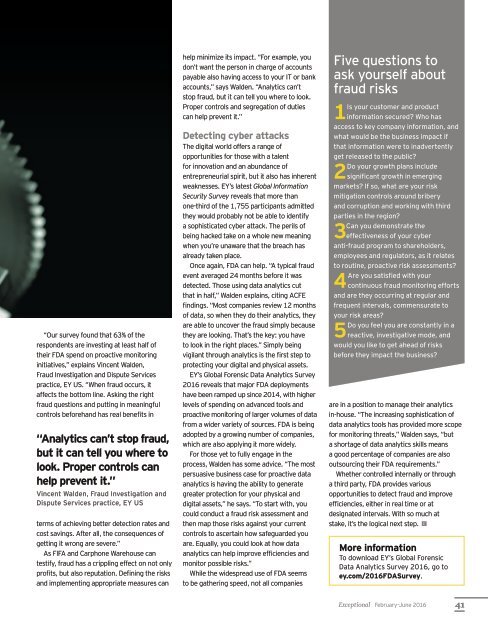Exceptional
ey-exceptional-2016-uki-book
ey-exceptional-2016-uki-book
You also want an ePaper? Increase the reach of your titles
YUMPU automatically turns print PDFs into web optimized ePapers that Google loves.
“Our survey found that 63% of the<br />
respondents are investing at least half of<br />
their FDA spend on proactive monitoring<br />
initiatives,” explains Vincent Walden,<br />
Fraud Investigation and Dispute Services<br />
practice, EY US. “When fraud occurs, it<br />
affects the bottom line. Asking the right<br />
fraud questions and putting in meaningful<br />
controls beforehand has real benefits in<br />
“Analytics can’t stop fraud,<br />
but it can tell you where to<br />
look. Proper controls can<br />
help prevent it.”<br />
Vincent Walden, Fraud Investigation and<br />
Dispute Services practice, EY US<br />
terms of achieving better detection rates and<br />
cost savings. After all, the consequences of<br />
getting it wrong are severe.”<br />
As FIFA and Carphone Warehouse can<br />
testify, fraud has a crippling effect on not only<br />
profits, but also reputation. Defining the risks<br />
and implementing appropriate measures can<br />
help minimize its impact. “For example, you<br />
don’t want the person in charge of accounts<br />
payable also having access to your IT or bank<br />
accounts,” says Walden. “Analytics can’t<br />
stop fraud, but it can tell you where to look.<br />
Proper controls and segregation of duties<br />
can help prevent it.”<br />
Detecting cyber attacks<br />
The digital world offers a range of<br />
opportunities for those with a talent<br />
for innovation and an abundance of<br />
entrepreneurial spirit, but it also has inherent<br />
weaknesses. EY’s latest Global Information<br />
Security Survey reveals that more than<br />
one-third of the 1,755 participants admitted<br />
they would probably not be able to identify<br />
a sophisticated cyber attack. The perils of<br />
being hacked take on a whole new meaning<br />
when you’re unaware that the breach has<br />
already taken place.<br />
Once again, FDA can help. “A typical fraud<br />
event averaged 24 months before it was<br />
detected. Those using data analytics cut<br />
that in half,” Walden explains, citing ACFE<br />
findings. “Most companies review 12 months<br />
of data, so when they do their analytics, they<br />
are able to uncover the fraud simply because<br />
they are looking. That’s the key: you have<br />
to look in the right places.” Simply being<br />
vigilant through analytics is the first step to<br />
protecting your digital and physical assets.<br />
EY’s Global Forensic Data Analytics Survey<br />
2016 reveals that major FDA deployments<br />
have been ramped up since 2014, with higher<br />
levels of spending on advanced tools and<br />
proactive monitoring of larger volumes of data<br />
from a wider variety of sources. FDA is being<br />
adopted by a growing number of companies,<br />
which are also applying it more widely.<br />
For those yet to fully engage in the<br />
process, Walden has some advice. “The most<br />
persuasive business case for proactive data<br />
analytics is having the ability to generate<br />
greater protection for your physical and<br />
digital assets,” he says. “To start with, you<br />
could conduct a fraud risk assessment and<br />
then map those risks against your current<br />
controls to ascertain how safeguarded you<br />
are. Equally, you could look at how data<br />
analytics can help improve efficiencies and<br />
monitor possible risks.”<br />
While the widespread use of FDA seems<br />
to be gathering speed, not all companies<br />
Five questions to<br />
ask yourself about<br />
fraud risks<br />
Is your customer and product<br />
1 information secured? Who has<br />
access to key company information, and<br />
what would be the business impact if<br />
that information were to inadvertently<br />
get released to the public?<br />
Do your growth plans include<br />
2 significant growth in emerging<br />
markets? If so, what are your risk<br />
mitigation controls around bribery<br />
and corruption and working with third<br />
parties in the region?<br />
Can you demonstrate the<br />
3 effectiveness of your cyber<br />
anti-fraud program to shareholders,<br />
employees and regulators, as it relates<br />
to routine, proactive risk assessments?<br />
Are you satisfied with your<br />
4 continuous fraud monitoring efforts<br />
and are they occurring at regular and<br />
frequent intervals, commensurate to<br />
your risk areas?<br />
Do you feel you are constantly in a<br />
5 reactive, investigative mode, and<br />
would you like to get ahead of risks<br />
before they impact the business?<br />
are in a position to manage their analytics<br />
in-house. “The increasing sophistication of<br />
data analytics tools has provided more scope<br />
for monitoring threats,” Walden says, “but<br />
a shortage of data analytics skills means<br />
a good percentage of companies are also<br />
outsourcing their FDA requirements.”<br />
Whether controlled internally or through<br />
a third party, FDA provides various<br />
opportunities to detect fraud and improve<br />
efficiencies, either in real time or at<br />
designated intervals. With so much at<br />
stake, it’s the logical next step.<br />
More information<br />
To download EY’s Global Forensic<br />
Data Analytics Survey 2016, go to<br />
ey.com/2016FDASurvey.<br />
<strong>Exceptional</strong> February–June 2016 41


